Journalists serve as middlemen, translators, interpreters and analysts — as bridges between individual experiences and broader community understanding. We couldn’t do this job if brave people didn’t open their lives to us, let us into their homes and businesses and share their perspectives to create a dialogue. Our sources are active participants in this community narrative we build together.
When our photographers go out into the world, we are sometimes met with negativity, wariness or even open hostility. Those reactions are understandable, especially from people who don’t know us or our intent. We often have just a few seconds to build trust and explain our intentions. In these moments, we are grateful to the people who let us in and allow us to capture their lives as we do our best to represent them with dignity, accuracy and respect. Journalism is not just about reporting facts but sharing the humanity behind those facts. Photographs are an incredibly powerful tool for sharing humanity.
This year, a few such people we photographed stand out for these reasons.
As part of our ongoing series on gun violence, in March we talked with the family of Abdikadir Shariif, a rideshare driver who was shot and killed in Edmonds by a stranger after dropping off a passenger. Though we were with them only a short time, Shariif’s family allowed us to speak with and photograph them during difficult and emotional moments at a memorial gathering for their son. Their grief is symbolic of the many grieving families across the state who have lost children to gun violence this year.
Over the summer, freelance photographer David Ryder worked on a story for Cascade PBS about the Biletskiy family, who fled the Russian invasion in Ukraine and moved to Washington with seven of their children. Their oldest son, Roman, 23, is a survivor of a 2022 massacre of Ukrainian prisoners of war, but remains a Russian captive. The Biletskiys let Ryder spend time with them at home, their business and during a rally commemorating the massacre. Their generosity and vulnerability allowed him to illustrate the difficulty they have had settling in a new place while still in a constant state of worry and uncertainty as they await news of their missing son and war-torn home country.
Another group that was tremendously generous with their insight and expertise was the medical staff at Harborview Medical Center. During our series on how health care professionals are affected by gun violence, a wide range of doctors, nurses and violence preventions specialists gave us some of their precious time and energy and allowed me to photograph them as they performed surgeries and worked with patients in the operating rooms and offices of the Level 1 Trauma Center. It can often be difficult to obtain access to photograph inside hospitals due to privacy concerns and the busy, often chaotic environment. These doctors and other staff know firsthand the severity and importance of the issues we were covering and did everything they could to help us tell the story.
These are just a few examples, but every time a community member opens their door and gives us a bit of their time, we are grateful. It helps us do our job better and tell your stories with context and compassion.
Thank you to everyone who let us into your lives and allowed us to share your stories of heartbreak and triumph with our readers.
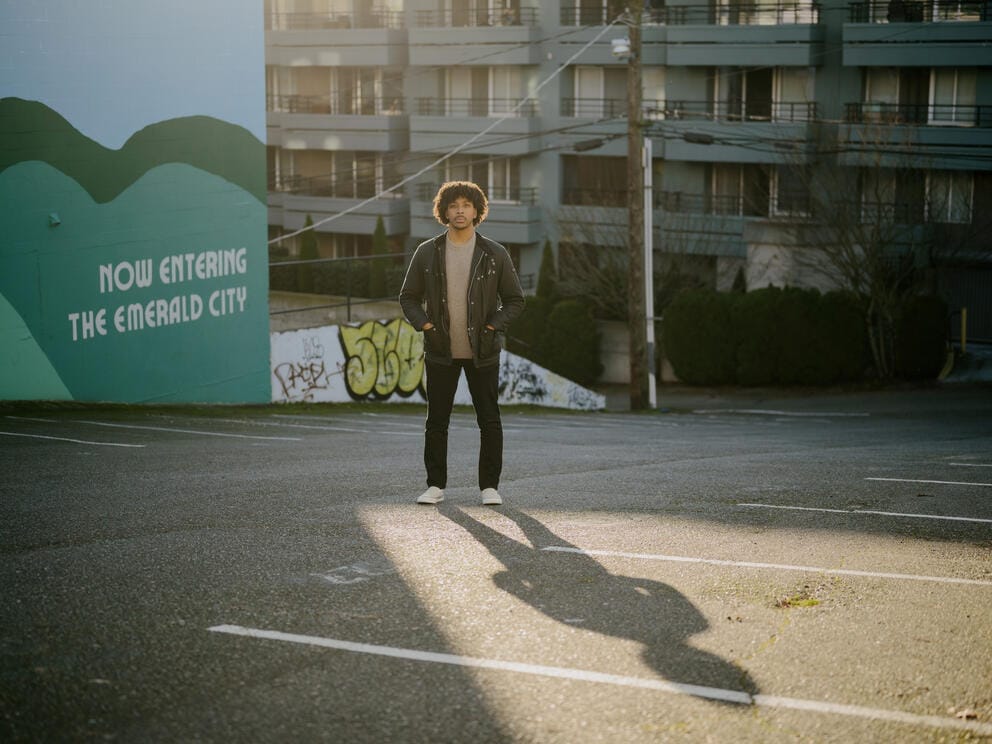
As part of a story checking in with young activists who led the 2020 Black Lives Matter protests, we followed up with Garin Peyton, who now channels his activism through social media, his music and podcast. “I really wanted to be part of something that actually made sense to what we can do in the future,” Peyton said. “If what happened in 2020 didn’t happen, I feel like we would still be behind.” Peyton pointed to an urgency for change and exhaustion as reasons why the on-the-ground organizers ended up burnt-out and disbanded. (Grant Hindsley for Cascade PBS)
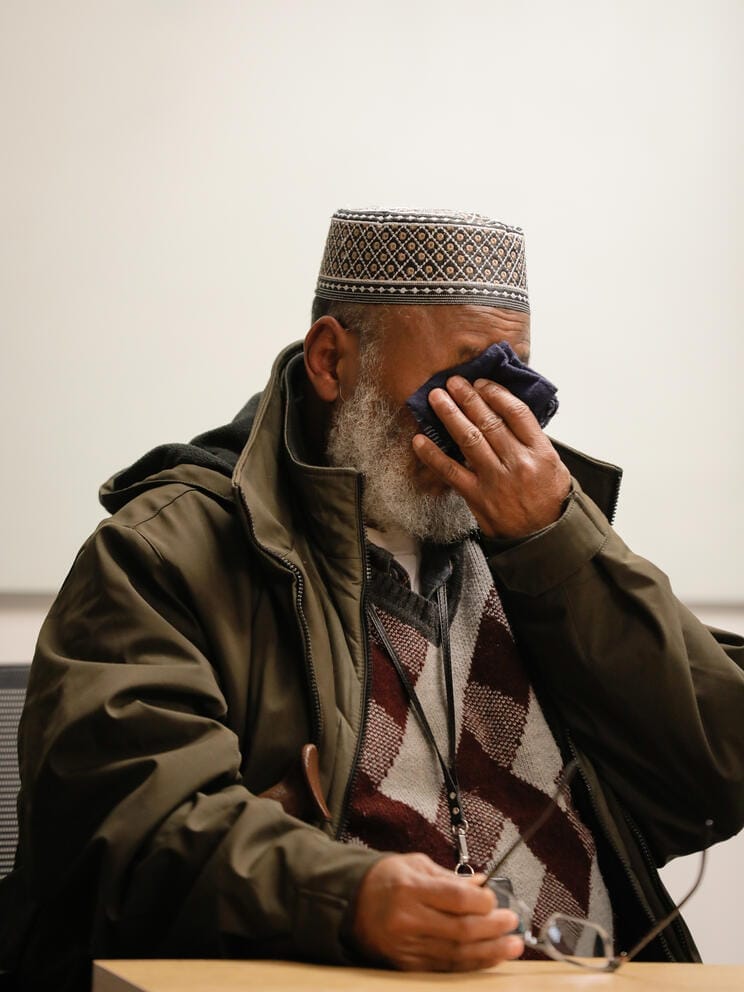
Abdikadir Shariif’s father Abdullahi Shariif Ali wipes away a tear during a gathering hosted by the Seattle Rideshare Drivers Association in honor of his son, who was shot and killed in January in Edmonds after dropping off a rideshare passenger.
Shariif Ali, who packed up his family, including newborn son Abdikadir, and fled the violence of the Somalian civil war in 1992, said “It never came to my mind that I would lose my son because of violence in the United States.” The Shariif family spent 17 years in a Kenyan refugee camp before getting the chance to move to the United States.
Abdikadir Shariif was the fifth rideshare driver killed in the Seattle area since 2020. Fearing more killings and other violence, rideshare drivers and advocates are calling on Seattle city officials to help them strategize ways to improve driver safety. (Genna Martin/Cascade PBS)
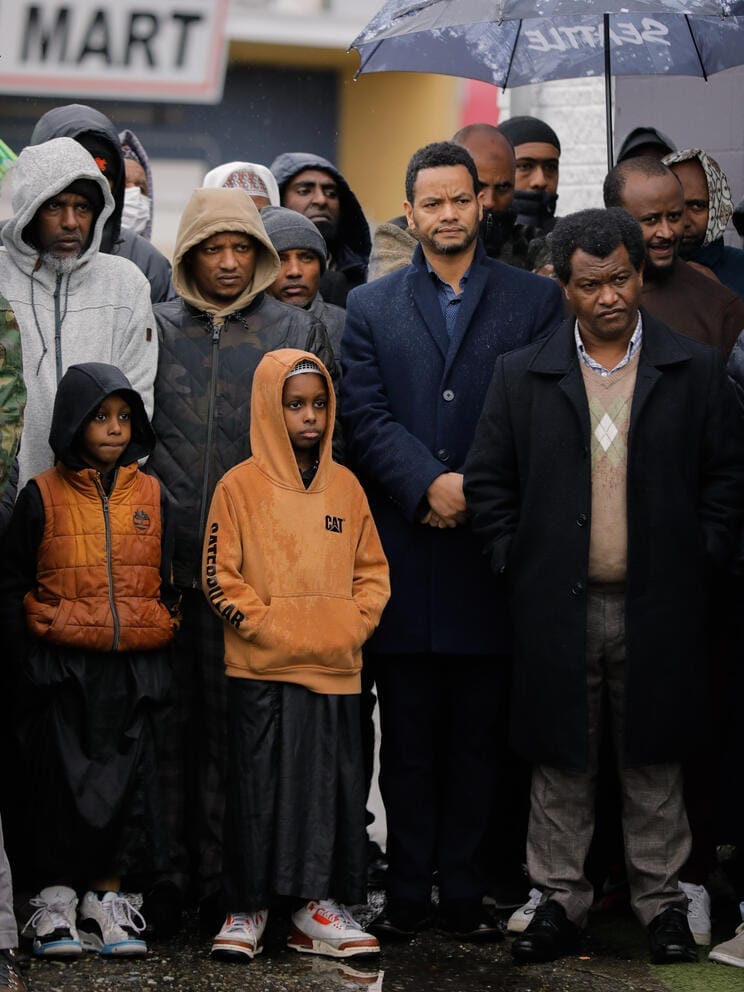
Community members, family and friends of Mubarak Adam, a 15-year-old who was fatally shot outside the Southwest Teen Life Center in West Seattle in January 2024, gather for a rally against gun violence in South Seattle, March 1, 2024. Gun violence incidents in Seattle spiked after the pandemic. Although overall numbers are now decreasing, youth gun violence, especially among men 13-23, has remained an enormous issue, with some data showing gun violence has become the leading cause of death for children ages 1-17 nationally. Communities are desperate for solutions to the violence. (Genna Martin/Cascade PBS)
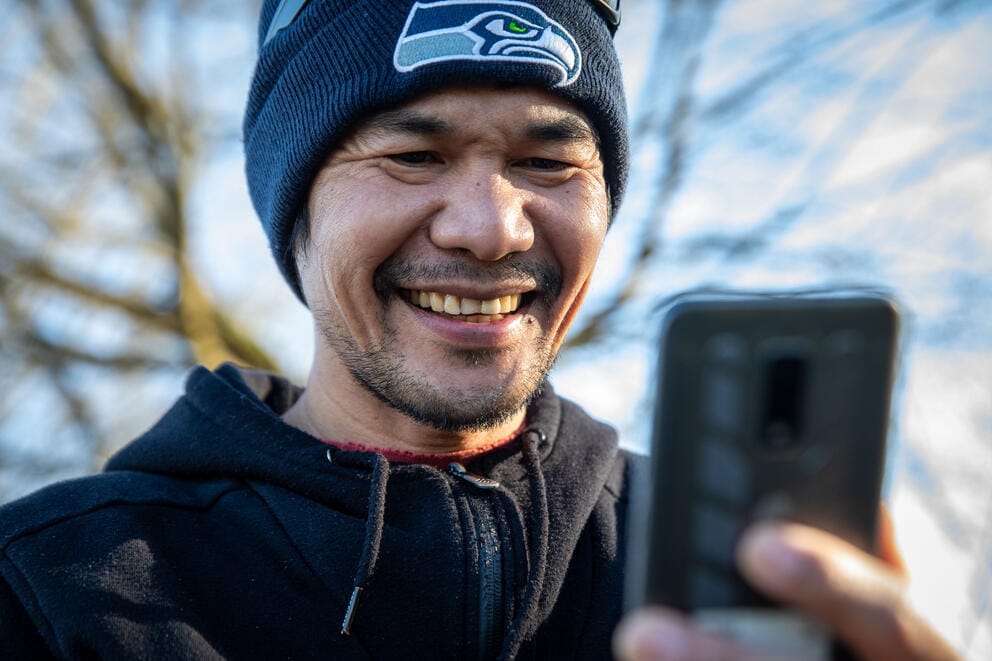
United 6 worker Norberto Cabrela tries to coax a smile from his infant son as he talks with his family back in the Philippines over video chat. Cabrela is one of 24 Filipino fishermen who were stranded in Westport Marina, confined to their boats. They’re accusing their their employer, McAdam’s Fish, of abandonment and wage theft. The men did not have visas, so they relied on McAdam’s to arrange their travel home. Legally they could not leave their boats without risking a large fine. Working offshore can leave foreign fishermen vulnerable to their employers’ interests, labor experts say. While most of the fishermen were eventually able to go home, Cabrela and five others stayed in Washington to assist in a federal investigation and fight for their unpaid wages. (Lizz Giordano/Cascade PBS)
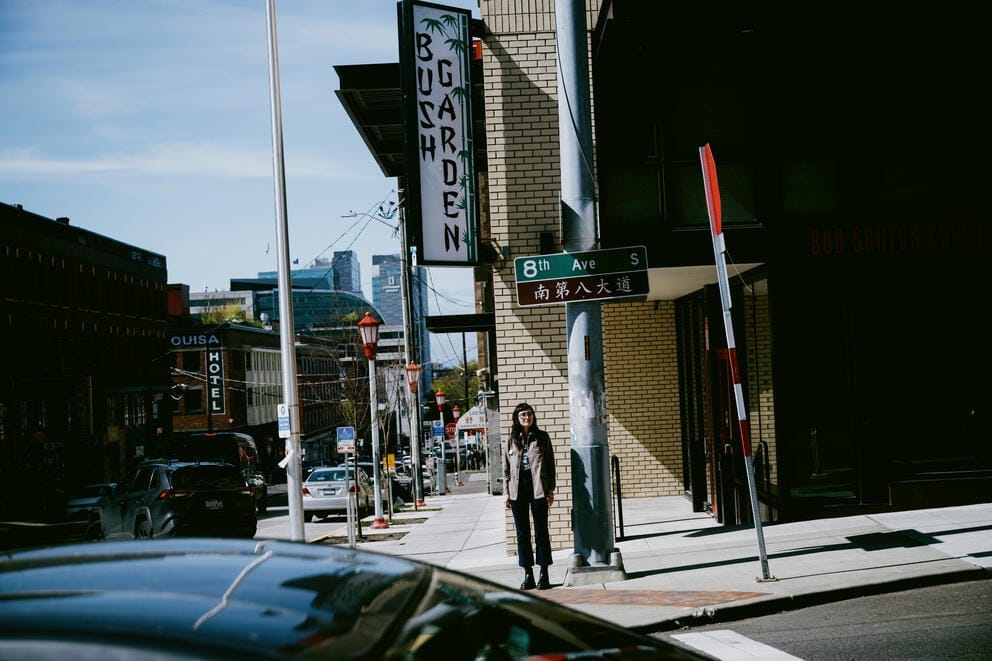
Our Northwest Reports podcast team spoke with Vanishing Seattle creator Cynthia Brothers in April about Seattle’s disappearing institutions and cultures. Brothers said she was heartbroken when popular CID restaurant and karaoke joint Bush Garden closed during the pandemic. The Seattle institution is expected to reopen at a new location in the near future. Freelancer Grant Hindsley captured this portrait of Brothers outside the new spot. (Grant Hindsley for Cascade PBS)
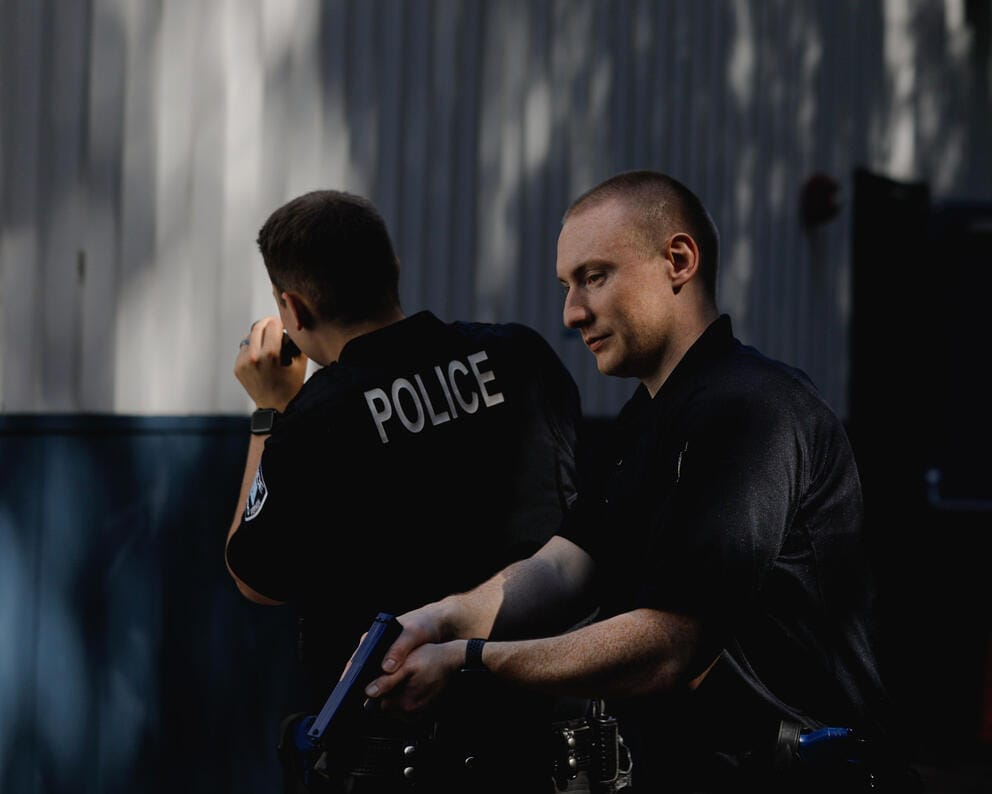
New police recruits practice clearing a building during training at Washington’s Criminal Justice Training Center. The Center is trying to train as many new recruits as possible this year to fill a statewide staff shortage. Washington has the lowest ratio of law officers to civilians in the nation at 1.12 per 1,000 people, down from 1.23 in 2019. Seattle Police staffing is at a 30-year low. The department said it had lost nearly 400 officers since January 2020, hiring only 145 in that same period. A national trend mirrors Seattle’s experience, with U.S. police departments losing officers to resignations and retirement far faster than they can hire replacements. (Genna Martin/Cascade PBS)
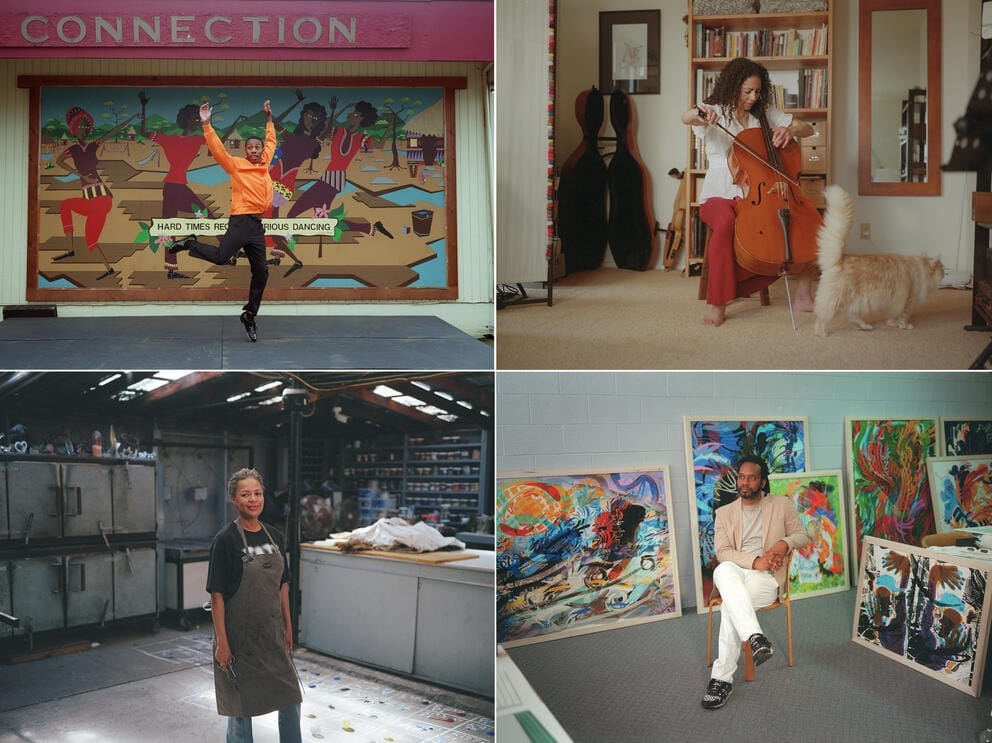
In April, the third season of our annual Black Arts Legacies multimedia collaboration debuted, highlighting the long-standing, vital and ongoing role of Black artists and Black arts organizations in the Seattle-area cultural landscape. Photographer Meron Menghistab photographed eight local artists this year, including (clockwise from top left) tap dancer and choreographer Cipher Goings; cellist and composer Gretchen Yanover; painter and muralist Moses Sun and glass artist Debora Moore. (Meron Menghistab for Cascade PBS)
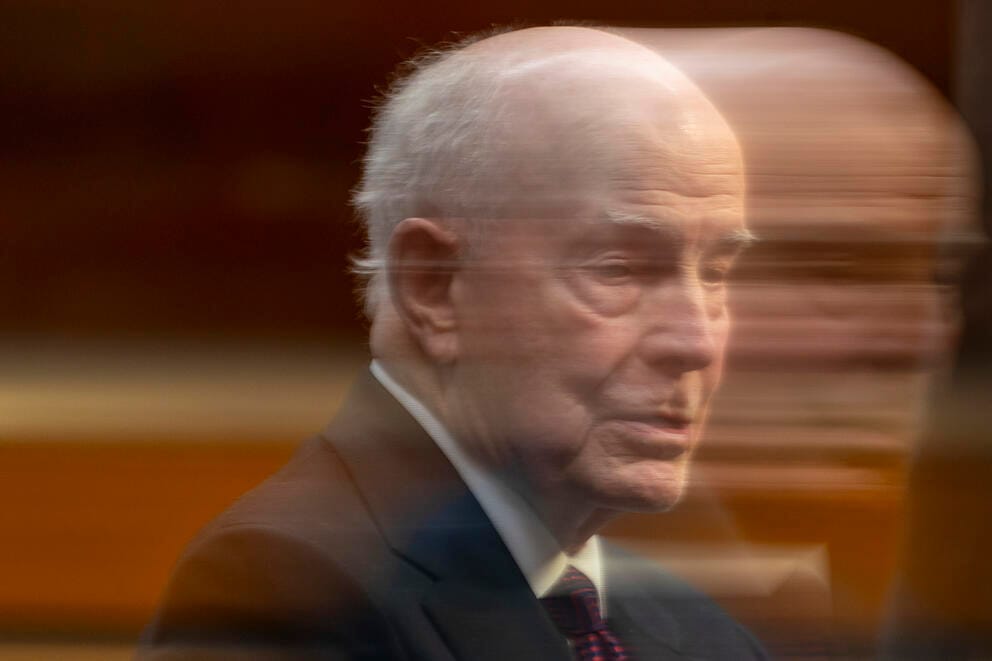
Former Gov. Dan Evans was Washington state’s 16th governor, from 1965 to 1977, and was a U.S. senator from 1983 to 1989. He died in September at age 98. Freelance photographer David Ryder captured this photo of Evans at an event hosted by the Northwest Power and Conservation Council at the Evergreen State College in Olympia, Washington, on April 9, 2024. (David Ryder for Cascade PBS)
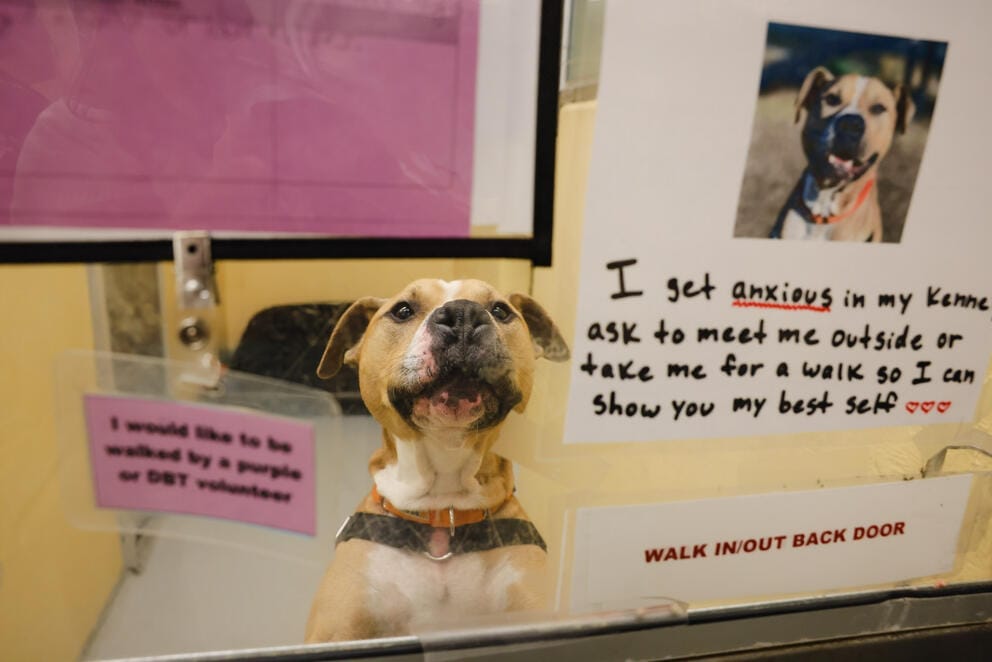
The Investigations team looked into safety and retaliation concerns voiced by current and former staff at the Seattle Animal Shelter. One of the concerns was about volunteer dog walkers and adoptive families not being alerted to potentially risky dogs with a history of biting. When we visited in April, a sign on Theon’s kennel at the Seattle Animal Shelter explains to staff, volunteers and prospective adopters that he can be anxious and does better outside. Several months after our investigation was published, the director of the shelter, Esteban Rodriguez, stepped down. (Genna Martin/Cascade PBS)
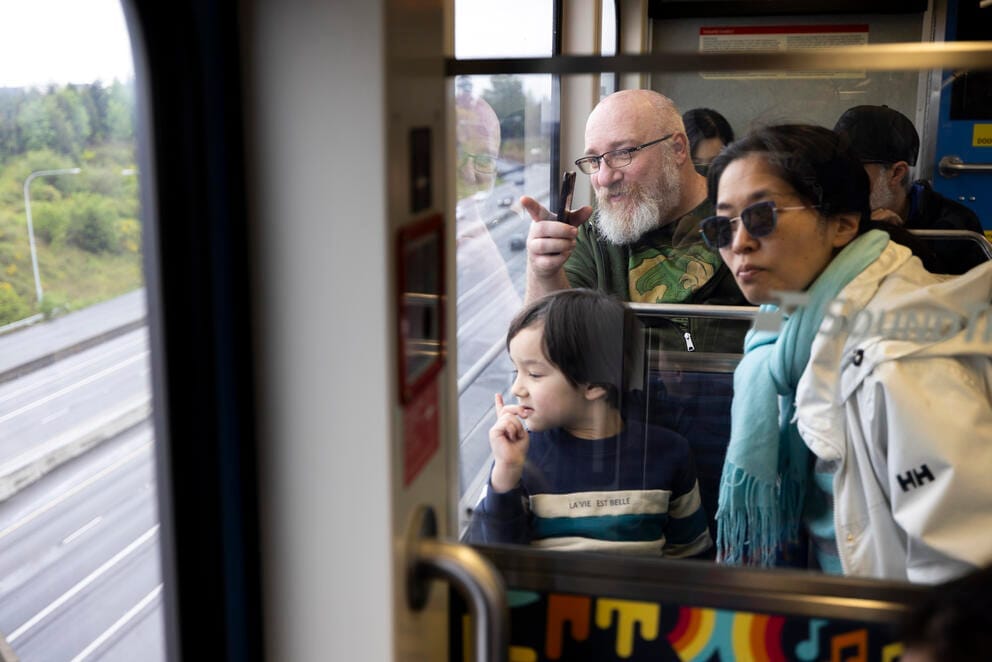
Passengers take in the view from above State Route 520 during the opening day of Sound Transit’s 2 Line light-rail service on Saturday, April 27, 2024. King County residents flocked to Bellevue on opening day to be among the first to ride the new line. In this photo, freelancer Jason Redmond captured the magic and excitement of public transit and the way a new train can make even adults feel like kids again. (Jason Redmond for Cascade PBS)
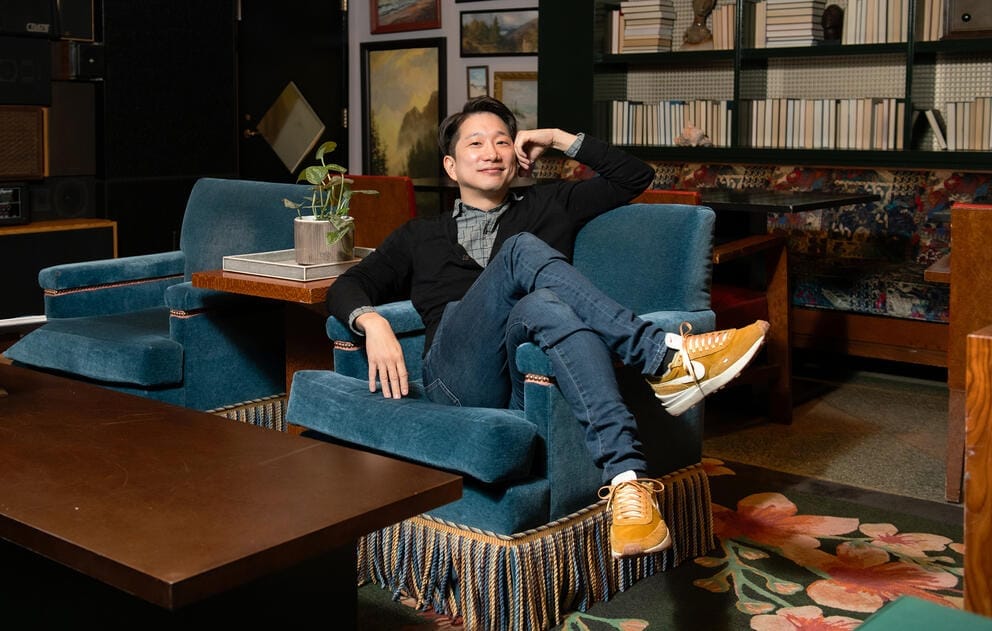
Caroline Walker Evans photographed writer and translator Anton Hur when he visited Seattle from Seoul to give a lecture at the University of Washington focusing on “the idea of voice in literary translation.” Hur uses his choice of books to translate to share aspects of his home in a more complex and nuanced way. “My translation project as a whole is about showcasing a Korea that is not what the mainstream cultural production would have you believe,” Hur said. “As in I want to showcase a Korea that’s more diverse. That’s more feminist. That’s more edgy.” (Caroline Walker Evans for Cascade PBS)
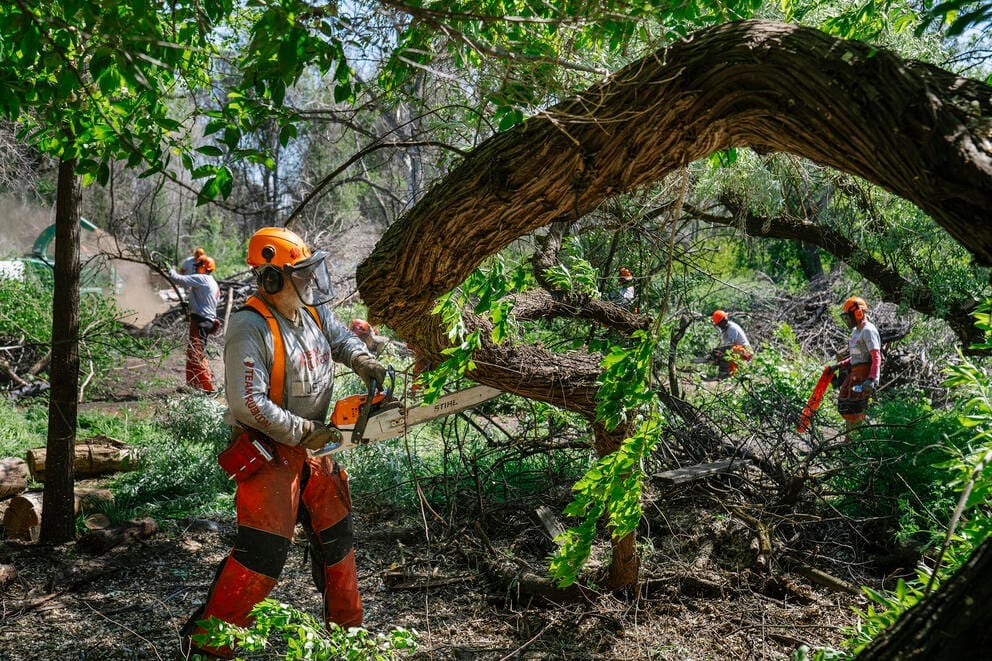
As the state geared up for wildfire season, M. Scott Brauer pitched and photographed a story for us about a group of volunteers working to remove burnable materials from an area outside of Kennewick. Here Jeff Sesak, of Samuels, Idaho, a Team Rubicon Sawyer 1, cuts up a tree to be removed during a fire mitigation project in Zintel Canyon, May 1, 2024. A crew of about 30 people worked to remove burnable materials, including standing trees and brush, organized by the Team Rubicon disaster response volunteer organization. Logs and woodchips from the operation are made available to the public. (M. Scott Brauer for Cascade PBS)
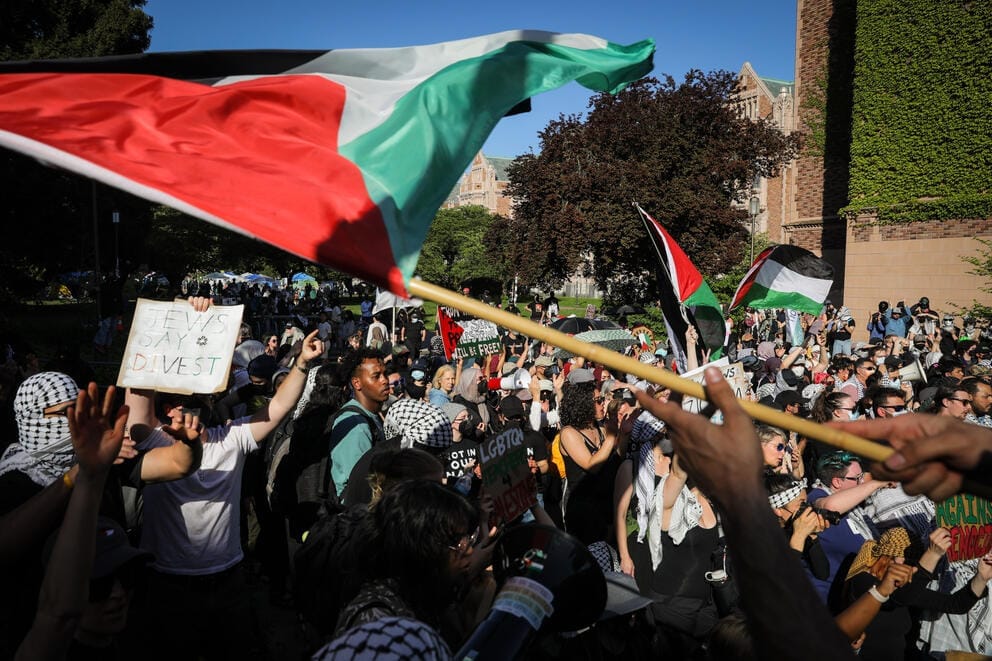
In early May, a group of UW students established their “Popular University for Gaza” encampment on the UW Quad, where they set up tents and lived for several weeks, expressing demands that the university divest and cut ties with Israel and Boeing. United Front member and UW graduate student Cera Hassinan said, “We want our University to care about changing the world, not contributing to killing people in Palestine.”
In this photo, pro-Palestinian protesters chant as a “United for Israel” counterprotest march passes the University of Washington Quad, Sunday, May 12. (Genna Martin/Cascade PBS)
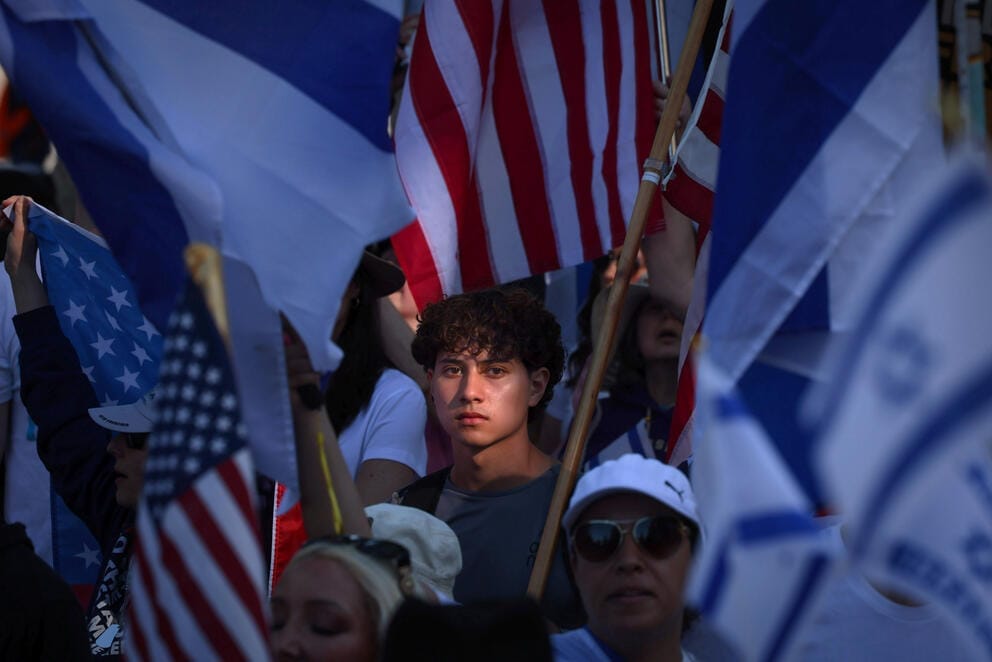
On May 12, a “United for Israel” march, organized by Pursuit Seattle Church, marched through the UW campus where a pro-Palestine group had been camping for weeks on the quad. The event involved some verbal confrontation between the two groups, who were kept separate by barricades and the University police but remained peaceful. Amid a sea of flags and signs, one demonstrator’s face stood out, illuminated by the afternoon sun. (Genna Martin/Cascade PBS)
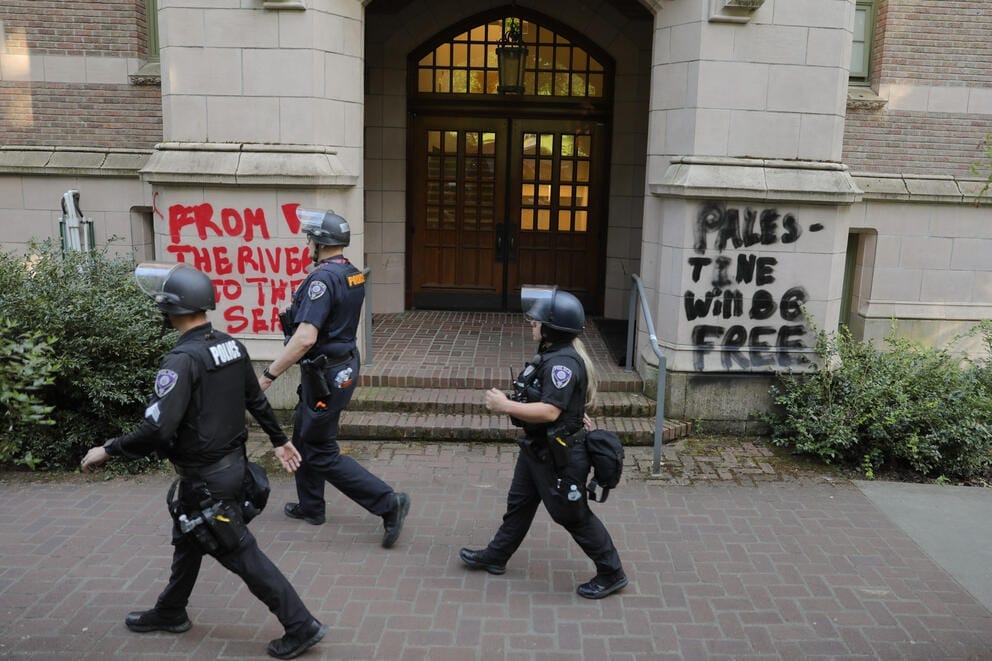
University of Washington police walk past a building marked with pro-Palestinian graffiti on Sunday, May 12. University President Ana Mari Cauce criticized the “Popular University for Gaza” encampment protest that took over the UW Quad for two weeks in May after many campus buildings were spray-painted with graffiti. She called some of graffiti both antisemitic and violent, “creating an unwelcome and fearful environment for many students, faculty and staff, especially those who are Jewish.” The school eventually reached a deal with protesters that involved a number of concessions, including future scholarships for displaced Palestinian students from Gaza and a non-retaliation policy toward students and staff who participated in the encampment. (Genna Martin/Cascade PBS)
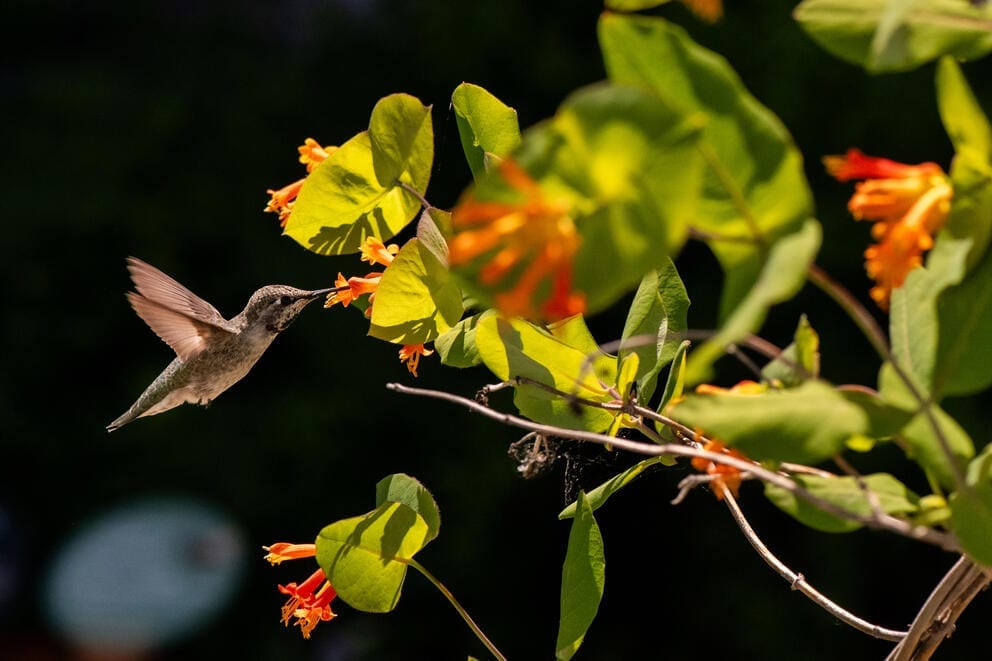
Hummingbirds fly around a Western trumpet honeysuckle vine planted along the new Pollinator Path at the Pacific Science Center. The multisensory exhibit, which opened last spring, focuses on the intertwined and cyclical relationships between humans and regional pollinators and introduces a Native-led interpretive approach to the natural world. (Caroline Walker Evans for Cascade PBS)
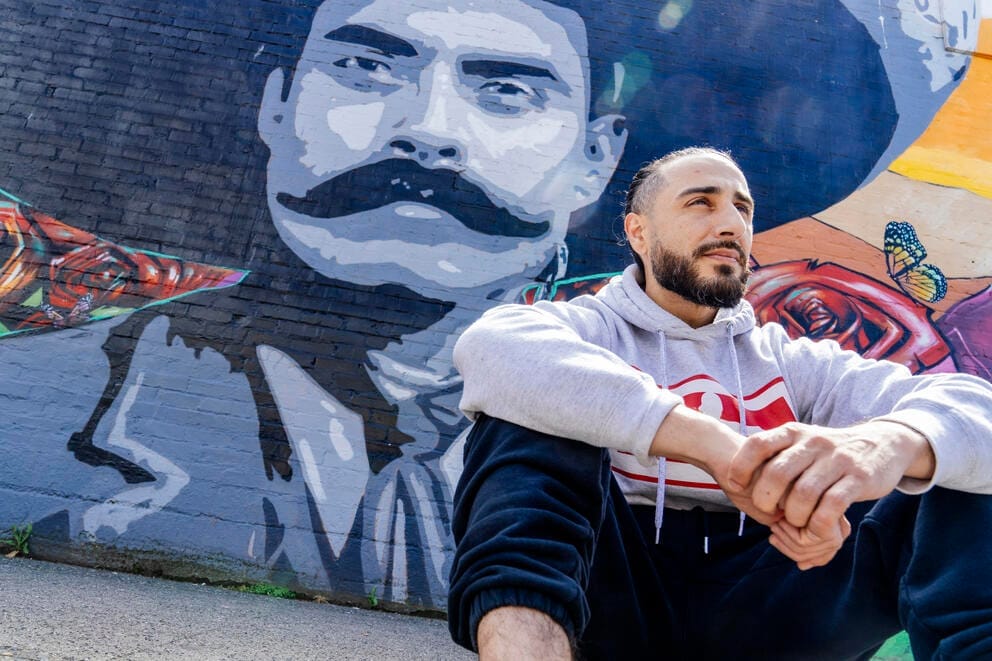
Mural artist Crick Lont (known as dozer_art on social media) is seen next to a commissioned mural he painted, with local graffiti writer Charms, on the exterior of La Esperanza Mercado y Carniceria in Beacon Hill, Thursday, May 30, 2024. The mural features a large portrait of Mexican revolutionary Emiliano Zapata alongside the landscape, flora and fauna of the Sonoran Desert. The pair painted the mural in 2020 and, Lont says, wanted it to “reflect the community.” The mural is a mixture of stenciled and freehand spray-paint art. This year the state began using drones to paint over graffiti in hard-to-reach places. Artists like Lont see his own work as something that can bring the community together. (M. Scott Brauer for Cascade PBS)
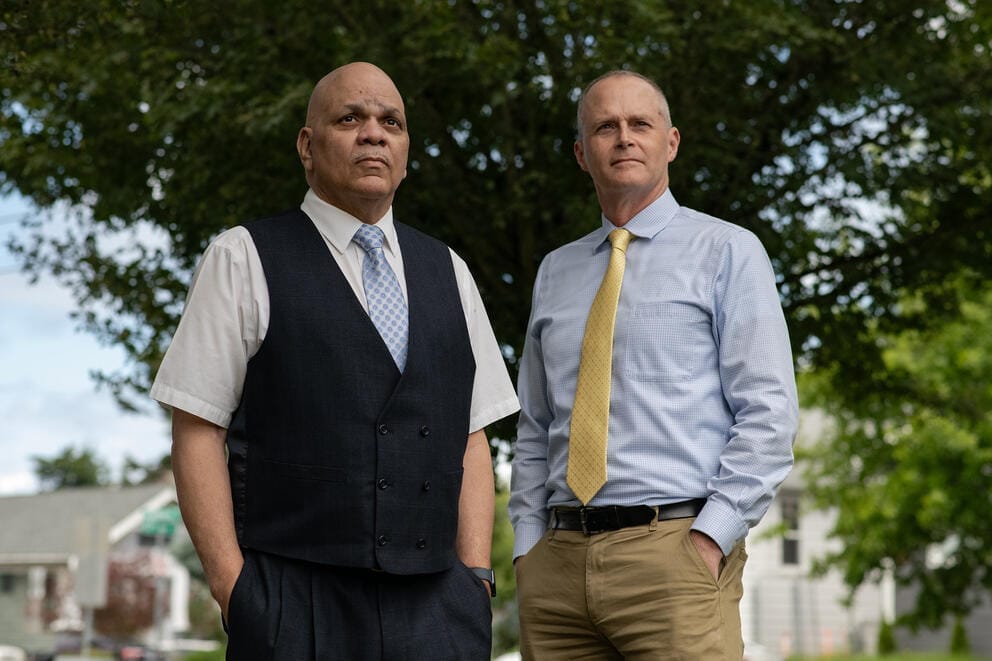
In June, Caroline Walker Evans photographed Doug Galuszka and Cortez Hopkins, who sent in a tip exposing deteriorating conditions of a building on the Seattle VA Campus, and alleged whistleblower retaliation for raising the issue of the horrible conditions on campus. Following the Cascade PBS investigation, the clinic was closed due to concerns about mold and ceiling leaks. (Caroline Walker Evans for Cascade PBS)
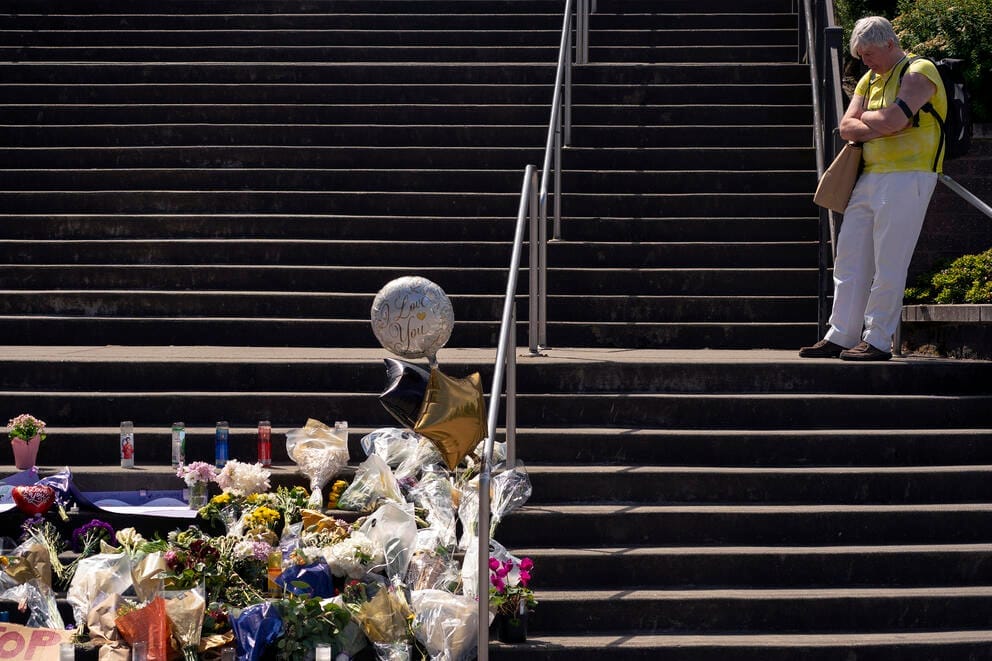
Tom Hundley pauses to reflect after leaving items at a memorial for Amarr Murphy-Paine at Garfield High School on June 8, 2024. While trying to break up a fight, Murphy-Paine, 17, was shot and killed in the school’s parking lot. He was one of many teenage gun violence victims in Seattle this year. (David Ryder for Cascade PBS)
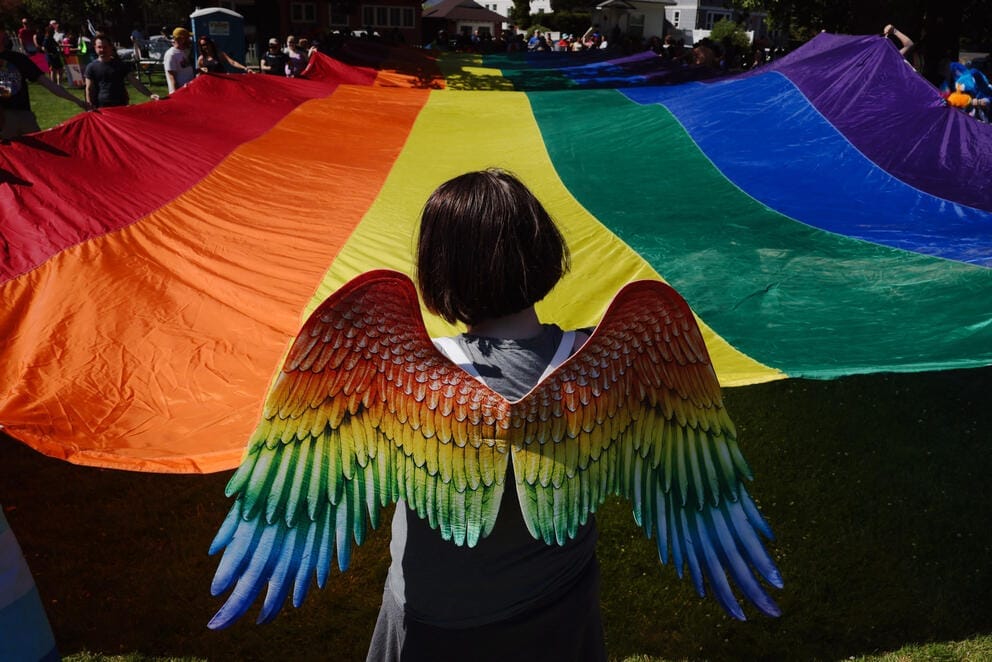
Eden Ruland holds a giant Pride flag at the start of the Yakima Pride Parade, June 8, 2024. In June, the Yakima City Council rejected a Pride Month proclamation it had made in previous years. The decision was symbolic of growing conservative control of the Council. Weeks after the proclamation was rejected, 5,000 people participated in a series of June events organized by Yakima Pride, a nonprofit that advocates for the city’s LGBTQ+ community, including a parade, a family fun fair, a prom and a drag performance at State Fair Park. (Genna Martin/Cascade PBS)
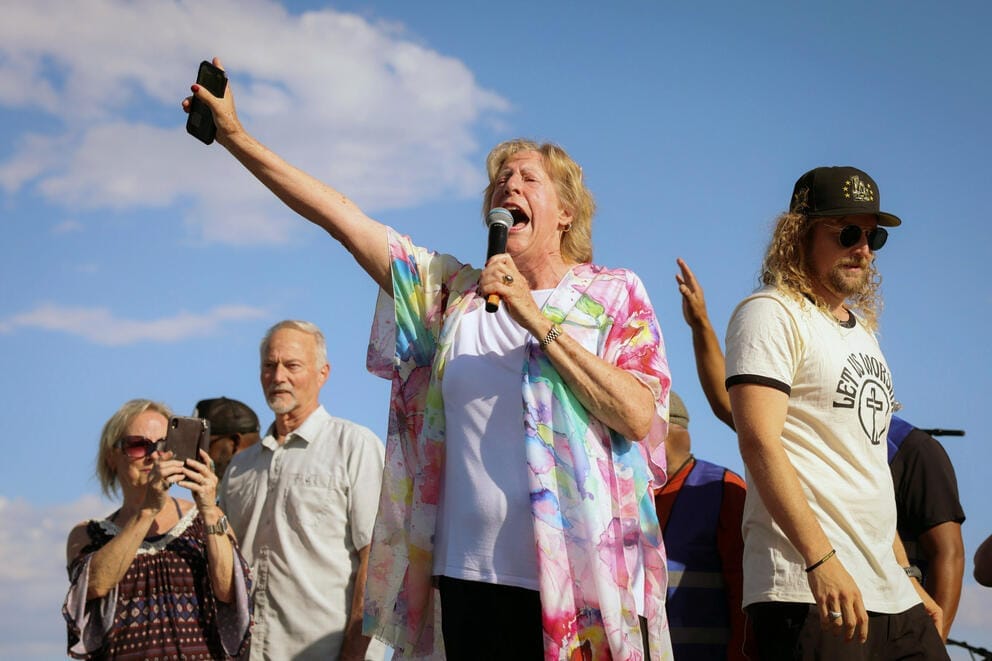
Yakima Mayor and city councilmember Patricia Byers, center, speaks on stage with other local leaders and pastors as Christian singer and worship leader Sean Feucht, right, fires up the crowd during his “Let Us Worship” Christian revival event at Sozo Sports Complex in Yakima, June 9, 2024. During the event, Feucht made calls to “push back” against the “perversion and darkness” of liberals and the LGBTQ+ community. Byers leads the Yakima City Council, which swung to a conservative majority this year. (Genna Martin/Cascade PBS)
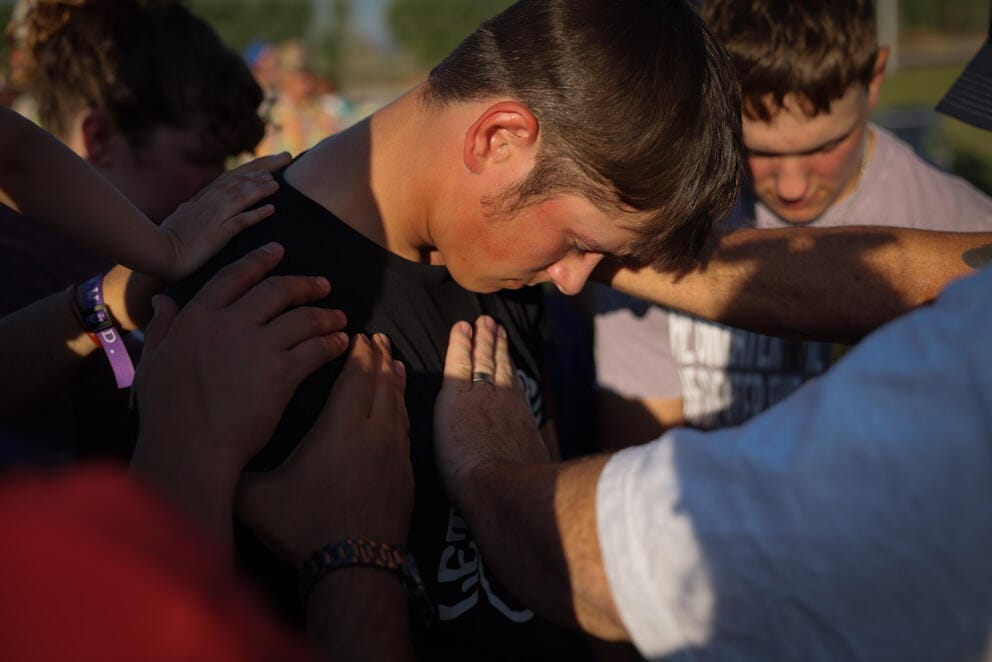
Attendees pray over a young man at the “Let Us Worship” event, June 9, 2024. Over the summer we covered a cultural clash in Yakima as the LGBTQ+ Pride festival was held the same weekend as a Christian revival event led by far-right worship leader Sean Feucht. Feucht praised Yakima, in contrast, for remaining a “family city,” saluting Yakima Mayor Byers, whom he called to the stage, for voting to reject the Pride Month proclamation. (Genna Martin/Cascade PBS)
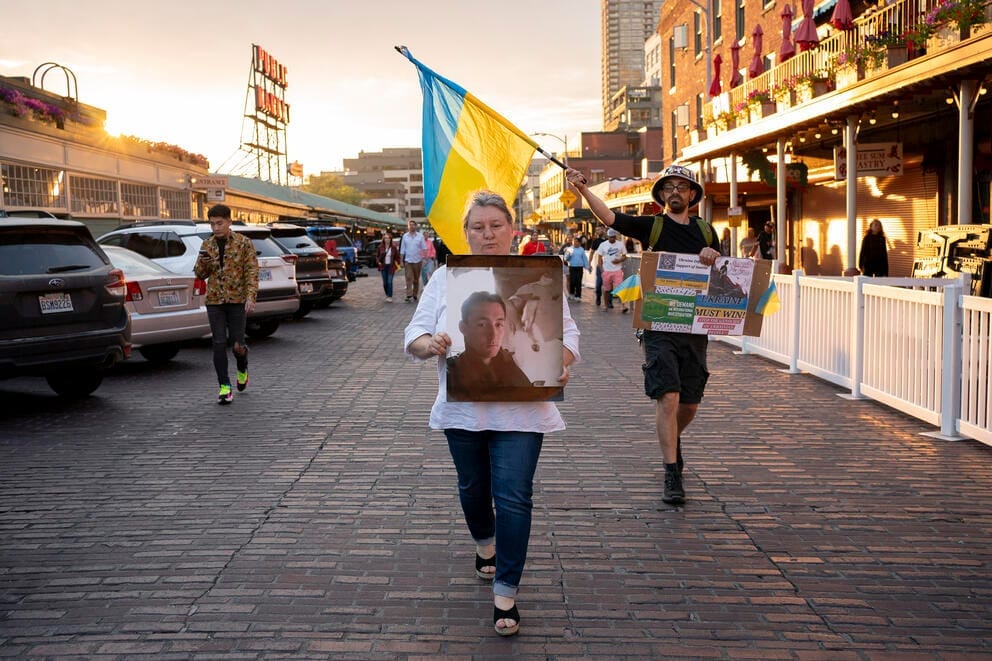
Valeria Biletska, center, carries a picture of her son, Roman Biletskiy, during a rally in Seattle on July 28, 2024, to commemorate the 53 Ukrainian prisoners of war who were massacred in a Russian prison. Roman Biletskiy, 23, a survivor of the massacre, is still in Russian custody. David Ryder spent time with Valeria, her husband Roman and their seven other children, who fled the Russian invasion for the U.S. two years ago. The family has had difficulty feeling settled as they wait for news about their oldest son and watch the ongoing conflict ravaging their home country. (David Ryder for Cascade PBS)
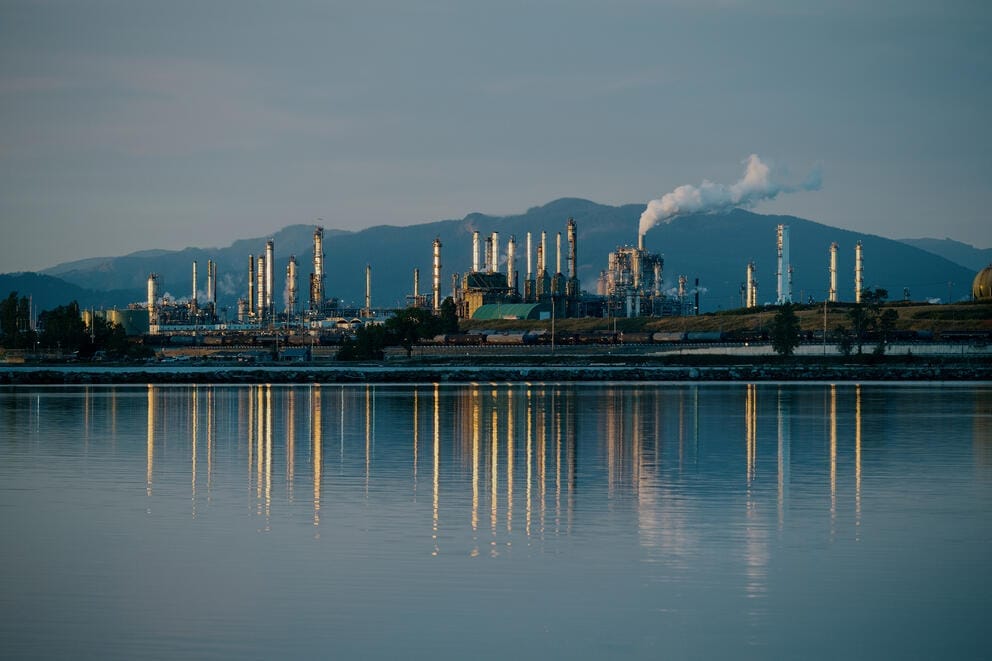
Carbon tax and energy costs were a frequent topic of reporting this year. Grant Hindsley photographed Marathon’s refinery on March Point, just outside Anacortes, Wash., on Aug 1, 2024. Despite concerns about increased gas prices, Washington voters decided this November to keep the new carbon pricing system, which aims to reduce greenhouse-gas emissions by selling carbon credits to polluting companies. So far the program has raised about $2 billion for environmental projects. (Grant Hindsley for Cascade PBS)
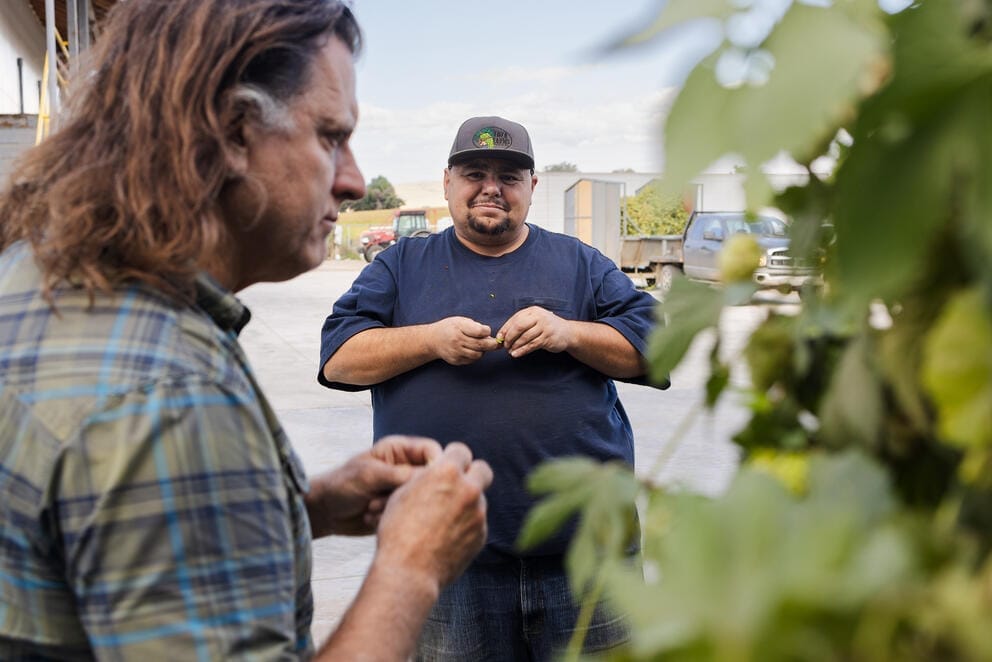
In September, photographer Emree Weaver spent time in the Yakima Valley with the Loza family, who run the nation’s only Latino-owned hop farm, Loza Farms. Leon Loza Sr. bought the farm in 2006, just a few years before the craft brewing industry boom began. Now, Leon “Junior” Loza and his siblings are beginning to take on more of the business and are using their experience to help POC-owned breweries thrive. Loza Jr. said much of the hop industry is relationship-based, and the farm receives many visitors during harvest season. (Emree Weaver for Cascade PBS)
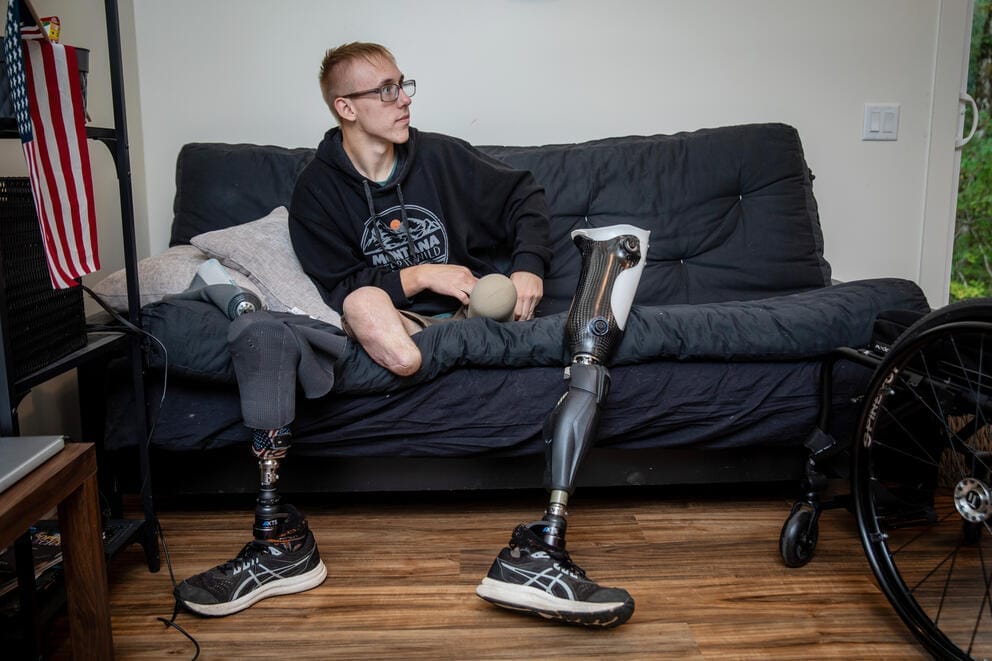
Derrik lost both his legs in June 2023, the summer after his sophomore year of high school, while working for a large construction company, Rotschy, in southwestern Washington as part of a school program that allowed him to earn class credit for hours on the job. An L&I investigation after the incident determined Rotschy not only allowed Derrik to use a machine prohibited for minors to use, but that the company also did not properly train him on it or closely supervise him. The agency issued the company a $156,259 fine and one willful serious violation. The company has racked up many of these fines and citations over the past few years for violating youth labor standards. The company is still allowed to hire minors through a school’s work-based learning program. (Lizz Giordano/Cascade PBS)
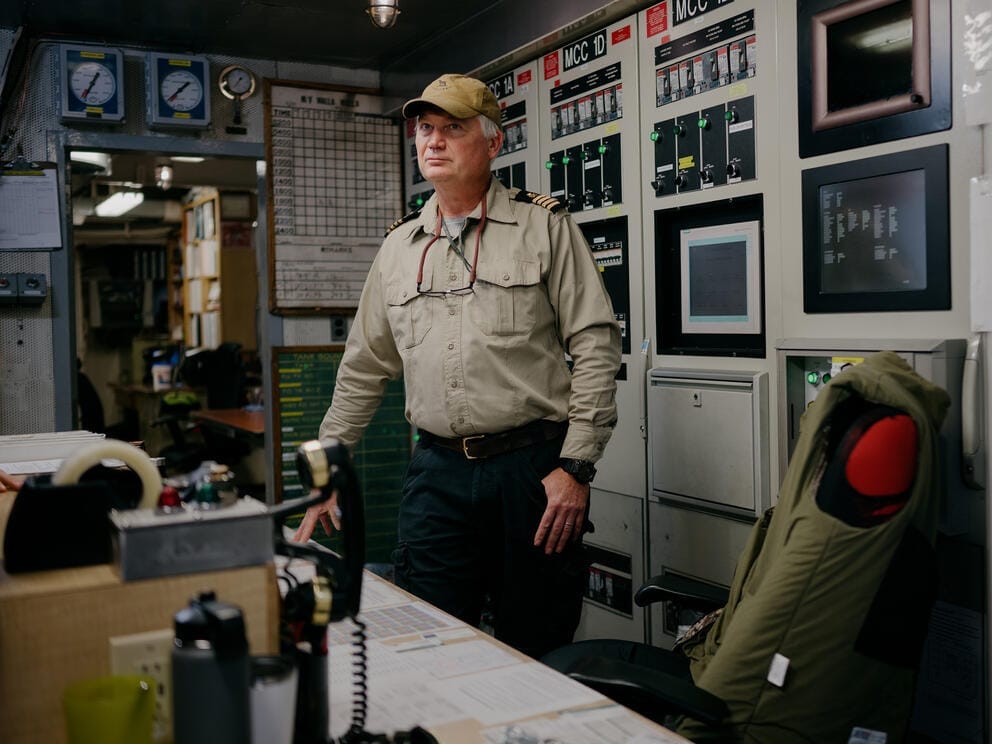
In September, Grant Hindsley photographed chief engineer Shawn McManus in the engine room of the Walla Walla ferry as Washington below-deck ferry workers, including engineers and oilers, fought for pay parity with above-deck crew. The workers’ union, which is not allowed to strike according to state law, argues that the mandated arbitration process that awarded them lower salary increases than their topside co-workers gives the state the upper hand in bargaining. (Grant Hindsley for Cascade PBS)
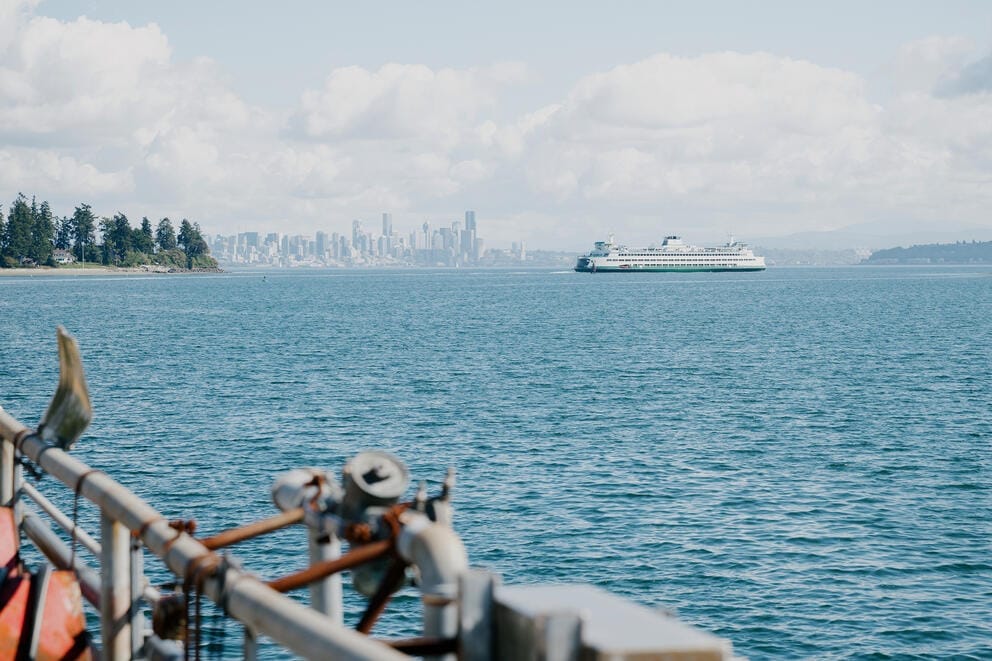
The Walla Walla heads back to Seattle from Bainbridge Island on Sept. 20, 2024. (Grant Hindsley for Cascade PBS)
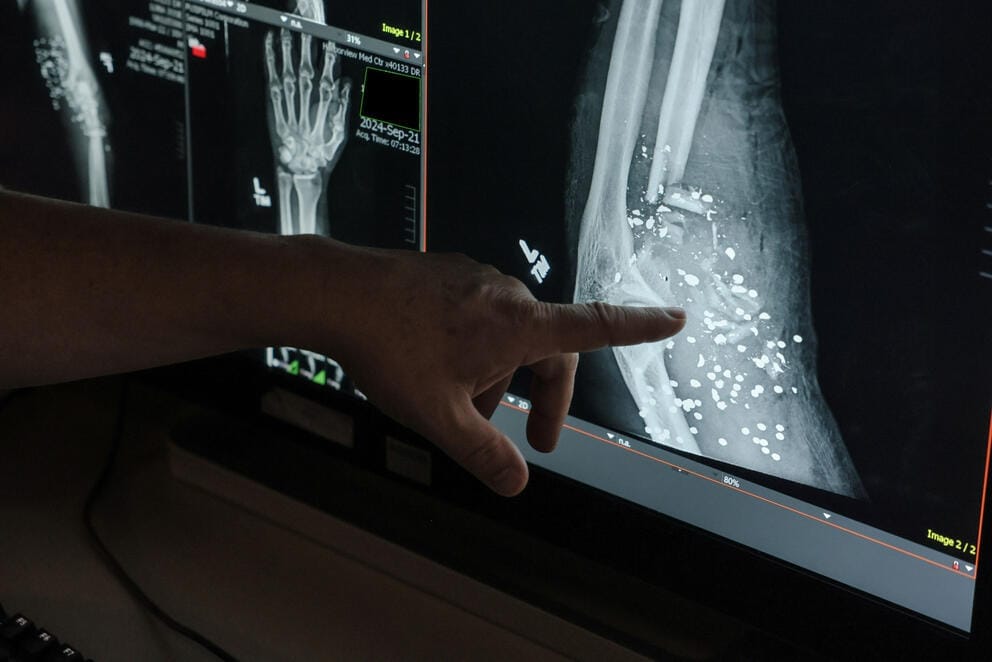
Emergency radiology section chief Dr. Ken Linnau looks over an X-ray that shows buckshot in the arm of a patient at Harborview Medical Center, Sept. 23, 2024. In September, Northwest Reports debuted a three-part series examining the impact of gun violence on medical professionals. The Level 1 Trauma Center at Harborview admits hundreds of gunshot victims per year, leaving lasting effects on the medical personnel who treat these patients. (Genna Martin/Cascade PBS)
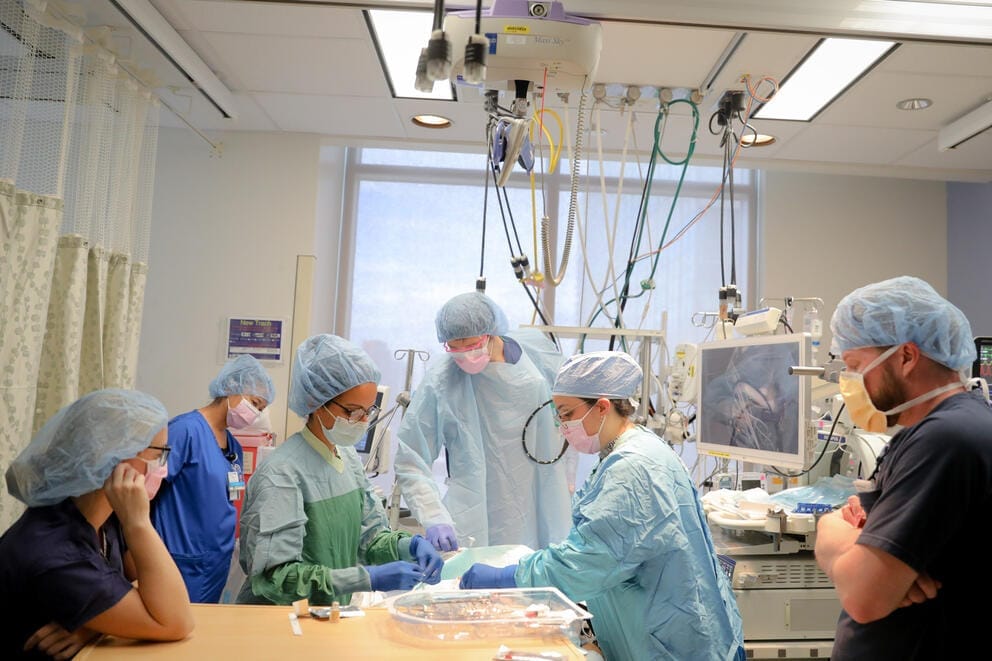
Dr. Deepika Nehra, third from left, and the trauma surgery team perform a feeding tube insertion procedure in the surgical ICU at Harborview Medical Center, Tuesday, Oct. 1, 2024. The trauma surgery team is critical in saving the lives of the many gunshot wound patients who come to Harborview from Washington, Idaho, Montana, Alaska and Wyoming. Some doctors, like Nehra, the founder and medical director of Harborview’s violence intervention program, are looking toward more holistic ways to prevent gun violence by finding longer-term ways to help patients recover and rebuild their lives after trauma. Harborview is the only medical institution in the state with violence-prevention intervention specialists on site. (Genna Martin/Cascade PBS)
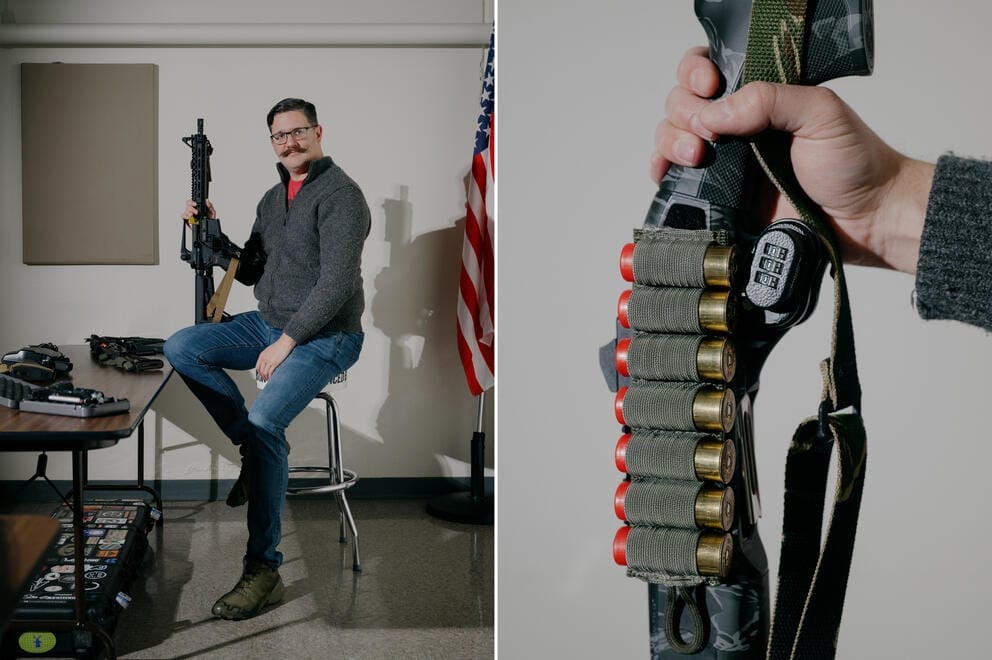
In a continuation of our series on gun violence, we reported on suicide prevention efforts across the state. Brett Bass, a former U.S. marine, firearm educator and University of Washington’s Safer Homes, Suicide Aware program coordinator, is working to encourage gun owners to properly store and lock up their firearms with tools like lock boxes and trigger locks to help avoid accidents and misuse. Rural counties often have higher reported rates of firearm suicides. Jefferson County reported a firearm suicide rate of 11.4 per 100,000 residents for the period between 2019 and 2023, compared to the statewide rate of 7.8 per 100,000. (Grant Hindsley for Cascade PBS)
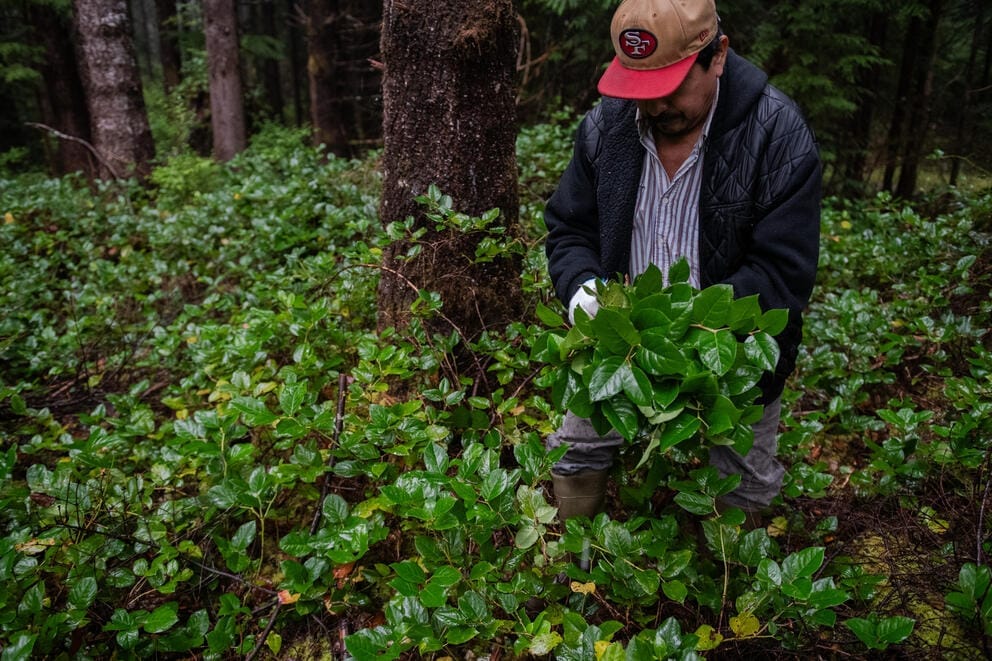
Caroline Walker Evans photographed Francisco Gomez Carlos harvesting salal deep in the Olympic National Forest. An experienced picker can collect up to 300 pounds of salal in a day. The plant is most often used for decorative floral arrangements. This fall our investigations team looked into complaints of dangerous working conditions, wage theft and other abuse within the brush-harvesting industry. Independently contracted migrant pickers have few protections against the unique physical and financial risks they encounter. (Caroline Walker Evans for Cascade PBS)
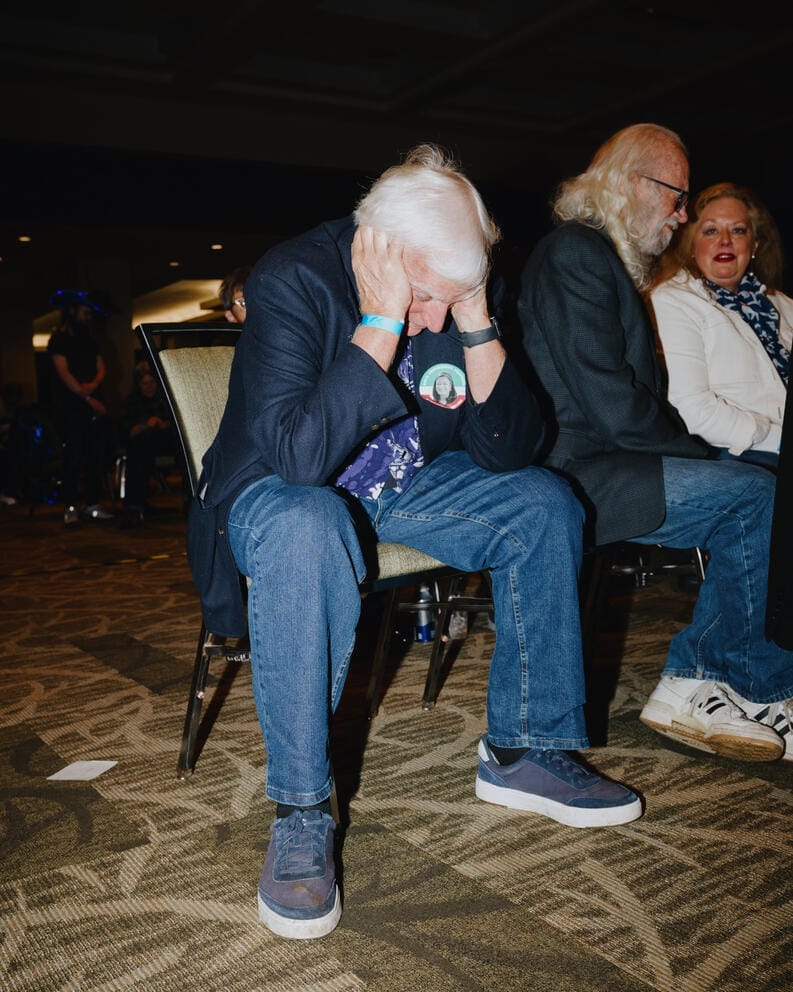
Grant Hindsley made this photograph at the Democratic Party election watch event at Seattle Convention Center Arch on Tuesday, Nov. 5, 2024, as attendees reacted to the incoming election results. It became clear later in the evening that Donald Trump would retake the presidency. (Grant Hindsley for Cascade PBS)
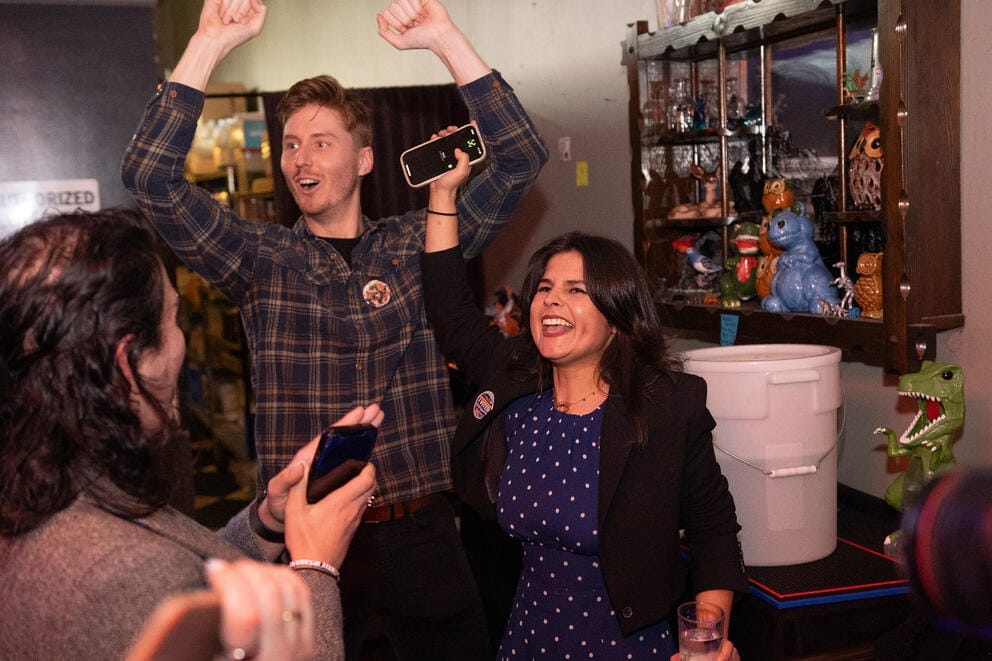
Chloe Collyer was on site election night to capture the moment Seattle City Council candidate Alexis Mercedes Rinck (right) took a commanding lead over incumbent challenger Tanya Woo in the polls. Rinck was officially sworn into the Council’s Citywide Position 8 seat in December. (Chloe Collyer for Cascade PBS)
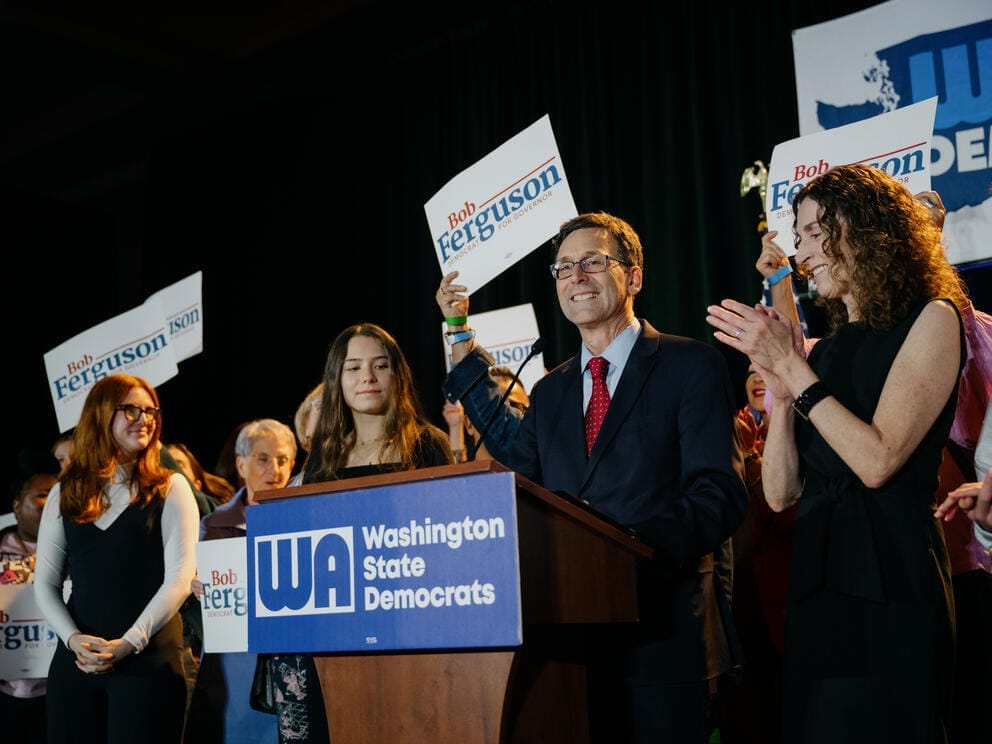
Washington Attorney General Bob Ferguson waves to the crowd as he speaks after a clear victory over Dave Reichert in Washington’s gubernatorial race at the Democratic Party election watch event at Seattle Convention Center Arch on Tuesday, Nov. 5, 2024. Current Gov. Jay Inslee decided not to run for reelection this year after 11 years as the state’s top official. (Grant Hindsley for Cascade PBS)


